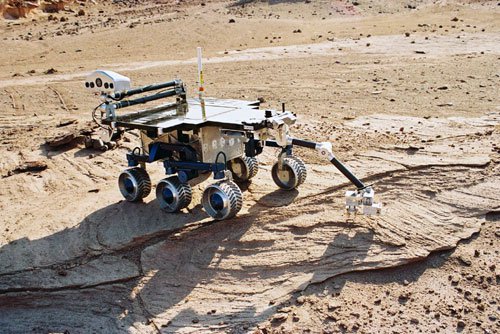
The FIDO rover placing a close focus imager against surface rocks during desert field tests.
We are developing a novel, end-to-end fully integrated system called SCAIP (Single Command Approach and Instrument Placement) that enables a rover to travel autonomously to a designated science target from 10 meters away and precisely place an instrument on that target with a single command, without additional human interaction. In addition, if access to the designated target is found to be unsafe, an auto-placement algorithm in SCAIP will autonomously determine if a suitable substitute site exists on the same rock and then proceed with the placement operation.
This work directly addresses issues related to the science objectives of the NASA Mars Exploration Office for (1) understanding the current state and evolution of the Martian surface, and (2) determining if life exists or has ever existed on Mars. SCAIP will enable efficient approach to and instrument deployment on science targets for the MSL mission, with a time savings of at least a factor of 2 on the approach and instrument placement operations and up to 20% more mission time for science compared to MER technology.
This enhanced performance is achieved through the novel target tracking and manipulator control algorithms integrated into SCAIP. For target tracking, we fuse 3-D information derived from feature operators, terrain data, and adaptive camera models to update the rover pose during the science target approach phase of SCAIP. For manipulator control, we have developed a Hybrid Image Plane/Stereo (HIPS) approach to generate camera models through direct visual sensing of markers on the manipulator's end-effector. These models are then used to precisely position the manipulator at a target location.
People on this Task
Max Bajracharya


